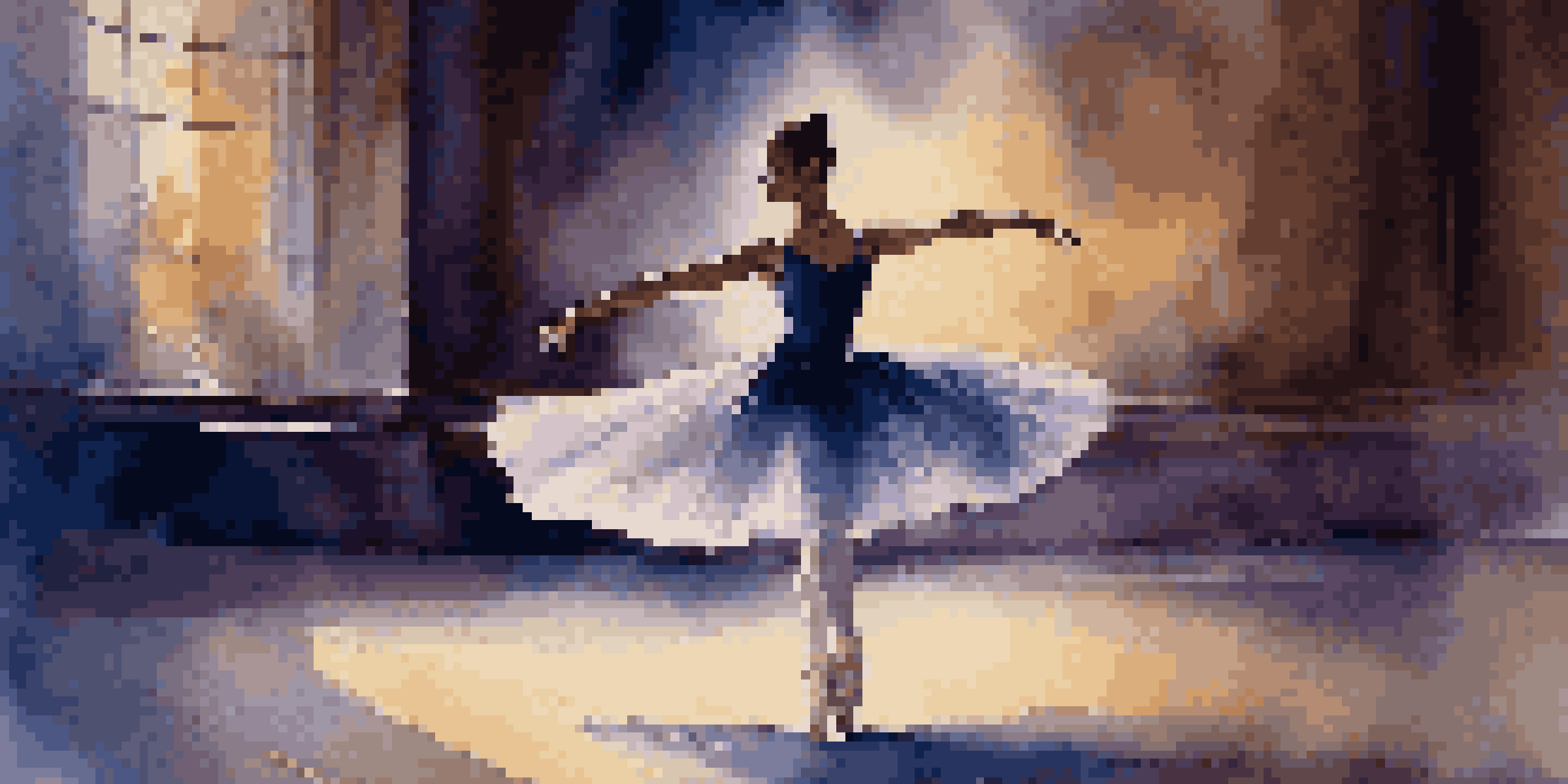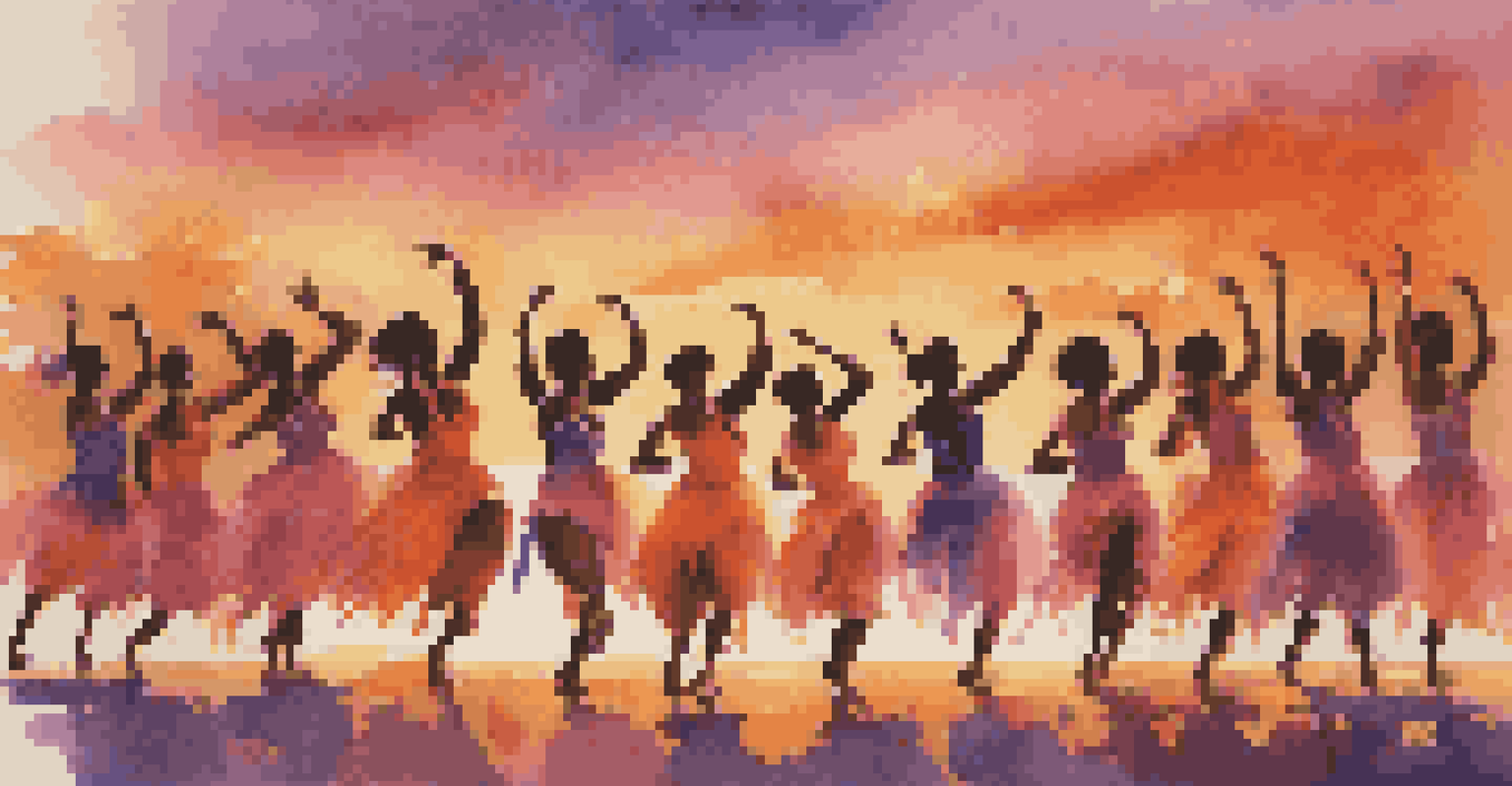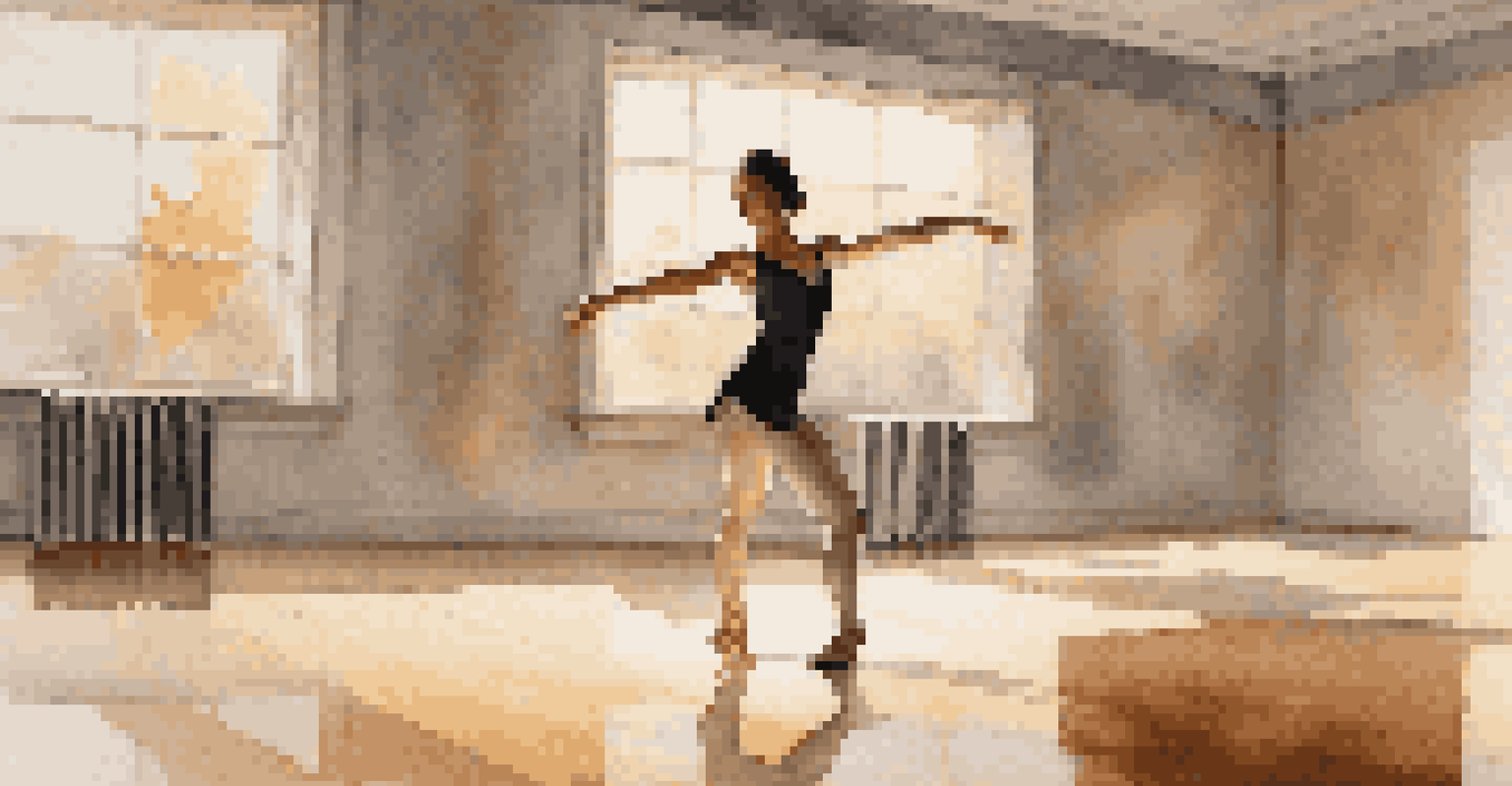The Art of Dance Descriptions in Literary Writing

Understanding the Essence of Dance in Writing
Dance is more than just movement; it’s an emotional expression that can convey stories without words. In literary writing, capturing the essence of dance involves understanding its rhythm, grace, and the energy behind each movement. This requires a writer to not only observe but also feel the dance, immersing themselves in the atmosphere to translate that into words. The goal is to evoke emotions in readers, allowing them to visualize the performance in their minds.
Dance is the hidden language of the soul.
For instance, consider a ballet performance. Describing a dancer’s pirouette might involve detailing not just the technical precision but also the grace and poise that captivates the audience. By tapping into the sensory experiences, such as the rustle of fabric or the soft landing on stage, a writer can create a vivid picture that resonates with readers. This approach invites them to experience the dance as though they are watching it live.
Moreover, understanding the different styles of dance, from contemporary to classical, can enhance your descriptions. Each genre has its unique qualities and emotional undertones, which can significantly influence how you depict movements. For example, a tap dance might evoke a sense of joy and playfulness, while a contemporary piece might explore deeper, more introspective themes.
Using Vivid Imagery to Enhance Dance Descriptions
Imagery is a powerful tool in literary writing, especially when describing dance. By employing descriptive language that appeals to the senses, writers can create a more immersive experience for their readers. Instead of simply stating that a dancer twirled, you might describe the way their skirt flared out like a blooming flower, capturing both the motion and the visual beauty of the moment.

Consider utilizing similes and metaphors to draw parallels between dance movements and familiar experiences. For example, you could liken a dancer’s leap to a bird taking flight, which not only enhances the imagery but also conveys a sense of freedom and exhilaration. This type of figurative language invites the reader to engage with the description on a deeper level, making the dance come alive in their imagination.
Dance as Emotional Expression
Capturing the essence of dance in writing involves conveying the emotions and stories behind each movement.
Additionally, incorporating specific details about the dancer’s physicality can enrich the description. Mentioning the tension in their muscles or the way their face reflects concentration adds layers to the narrative. This not only paints a clearer picture but also connects the reader emotionally to the performance, bridging the gap between the page and the stage.
Incorporating Emotion into Dance Narratives
Dance is inherently emotional, and capturing that in writing can elevate your descriptions significantly. To convey the passion or melancholy of a dance, consider exploring the dancer's feelings and intentions behind each movement. This approach allows readers to connect with the emotional core of the performance, making it more relatable and impactful.
To watch us dance is to hear our hearts speak.
For example, when describing a solo performance, you might delve into the dancer's backstory—perhaps they are expressing a sense of loss or joy. By providing context, you invite readers to understand the motivations behind the movements, creating a richer narrative. This deeper connection can lead to a more profound appreciation of the dance itself.
Furthermore, using emotional language can enhance the overall tone of your writing. Words that convey feelings of exhilaration, sorrow, or nostalgia can resonate with readers, allowing them to feel the performance rather than just observe it. This emotional engagement is key to making dance descriptions memorable and powerful.
The Role of Rhythm and Flow in Dance Writing
Just as rhythm is vital in dance, it’s equally important in literary writing. The flow of your sentences can mimic the cadence of a dance, drawing readers into the narrative. Short, sharp sentences might convey quick, energetic movements, while longer, flowing sentences can reflect the grace of a slow, lyrical piece.
For instance, if you’re describing a fast-paced jazz routine, a series of concise phrases can create a sense of urgency and excitement. In contrast, when illustrating a waltz, longer, more fluid sentences can evoke the elegance and romance of the dance. This rhythmic quality in your writing not only enhances the description but also mirrors the dance itself.
Imagery Enhances Dance Descriptions
Using vivid imagery and figurative language can create a more immersive experience for readers, allowing them to visualize the dance in their minds.
Additionally, varying the sentence structure can keep readers engaged, much like the unexpected turns in a dance performance. Creating a balance between short and long sentences, or alternating between complex and simple constructions, can maintain interest and enhance the overall reading experience.
Creating Context: Setting the Scene for Dance
The setting plays a crucial role in how dance is perceived and described in writing. A performance in a grand theater will evoke different feelings than one in an intimate studio or an outdoor festival. By establishing the context in which the dance takes place, writers can enhance the reader's understanding and emotional connection to the performance.
For example, describing the ambiance of a dimly lit room with soft music can set a serene tone for a contemporary dance piece. On the other hand, a vibrant street performance filled with colorful lights and enthusiastic crowds can convey energy and excitement. These contextual details help readers visualize the scene, making the dance more relatable and engaging.
Moreover, incorporating elements of the audience's reactions can further enrich the narrative. Mentioning how the crowd gasps in awe or bursts into applause can create a dynamic atmosphere that reflects the impact of the dance. This not only grounds the performance in reality but also brings the reader into the experience, making them feel like part of the audience.
The Importance of Practice and Observation in Dance Writing
To write compelling dance descriptions, practice and observation are paramount. Spending time watching various dance performances can provide insights into movement patterns, styles, and the emotions they evoke. This firsthand experience can inform your writing, allowing you to describe dances with authenticity and depth.
Additionally, consider attending dance classes or workshops yourself. Engaging with dance on a personal level can enhance your understanding of the physicality and artistry involved. This experiential knowledge can inform your descriptions, making them richer and more nuanced.
Practice Improves Dance Writing
Observing and experiencing dance firsthand enriches a writer's ability to describe movements authentically and with depth.
Moreover, observing dancers in different contexts—rehearsals, performances, and even casual settings—can help you grasp the subtleties of their movements. Noticing how they interact with music, space, and each other can inspire more vivid and accurate descriptions, ultimately elevating your literary portrayal of dance.
Editing and Revising Dance Descriptions for Impact
The editing process is crucial for refining dance descriptions and ensuring they resonate with readers. After drafting your initial descriptions, take a step back and evaluate whether they effectively capture the essence of the dance. Are the emotions conveyed? Does the imagery transport the reader into the performance? Revising with these questions in mind can lead to a more polished piece.
Additionally, consider seeking feedback from fellow writers or dance enthusiasts. Fresh perspectives can highlight areas that may need clarification or enhancement. This collaborative approach can be invaluable, as others may catch nuances that you might have overlooked.

Finally, don’t shy away from experimenting with different styles of writing during the editing process. Sometimes, rephrasing a description or trying out a new structure can uncover a more powerful way to convey the dance. The goal is to ensure that your final piece not only informs but also captivates and engages the reader.